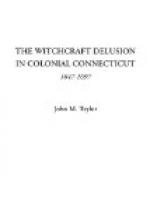Goody Seager probably deserved all that came to her in trials and punishment. She was one of the typical characters in the early communities upon whom distrust and dislike and suspicion inevitably fell. Exercising witch powers was one of her more reputable qualities. She was indicted for blasphemy, adultery, and witchcraft at various times, was convicted of adultery, and found guilty of witchcraft in June, 1665. She owed her escape from hanging to a finding of the Court of Assistants that the jury’s verdict did not legally answer to the indictment, and she was set “free from further suffering or imprisonment.” Records County Court (3: 5: 52); Colonial Records of Connecticut (2: 531); Rhode Island Colonial Records (2: 388).
JAMES WALKLEY. Hartford, 1662. Arrested. Fled to Rhode Island.
KATHERINE HARRISON. Wethersfield, 1669. Convicted; discharged.
See account in previous chapter. Records Court of, Assistants (I, 1-7); Colonial Records of Connecticut (2: 118, 132); Doc. History New York (4th ed., 4: 87).
NICHOLAS DESBOROUGH. Hartford, 1683. Suspicioned.
Desborough was a landowner in Hartford, having received a grant of fifty acres for his services in the Pequot war. He owes his enrollment in the hall of fame to Cotton Mather, who was so self-satisfied with his efforts in “Relating the wonders of the invisible world in preternatural occurrences” that in his pedantic exuberance he put in a learned sub-title: “Miranda cano, sed sunt credenda” (The themes I sing are marvelous, yet true).
Fourteen examples were chosen for the “Thaumatographia Pneumatica,” as “remarkable histories” of molestations from evil spirits, and Mather said of them, “that no reasonable man in this whole country ever did question them.”
Desborough stands in place as the “fourth example.” No case more clearly illustrates the credulity that neutralized common sense in strong men. It was a case of abstraction, or theft, or mistaken thrift. A “chest of cloaths” was missing. The owner, instead of going to law, found his remedy “in things beyond the course of nature,” and he and his friends with “nimble hands” pelted Desborough’s house, and himself when abroad, with stones, turves, and corncobs, and finally some of his property was burned by a fire “in an unknown way kindled.” Is it not enough to note that Mather closes this wondrous tale of the spiritual molestations with the very human explanation that “upon the restoring of the cloaths, the trouble ceased”?
ELIZABETH CLAWSON. Fairfield, 1692. Acquitted.
Account in previous chapter.
MARY and HANNAH HARVEY. Fairfield, 1692. Jury found no bill.
GOODY MILLER. Fairfield, 1692. Acquitted.
MARY STAPLIES. Fairfield, 1692. Jury found
no bill.
Account in previous chapter.
MERCY DISBOROUGH. Fairfield, 1692. Convicted; reprieved. Account in previous chapter. HUGH CROTIA. Stratford, 1693. Jury found no bill. Account in previous chapter. C. & D. (Vol. I,185).




